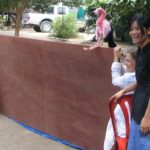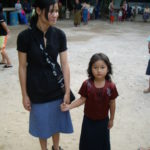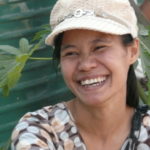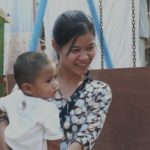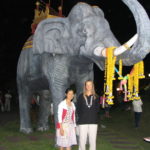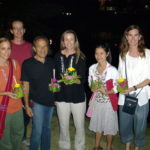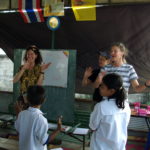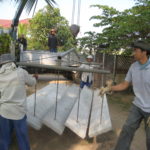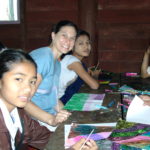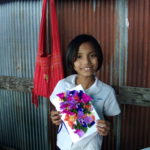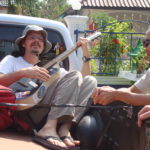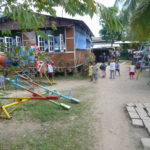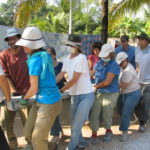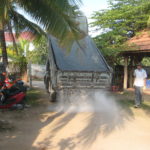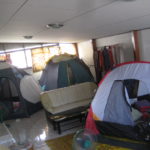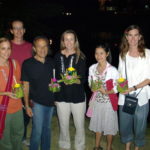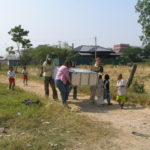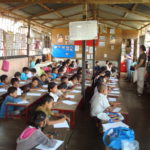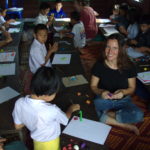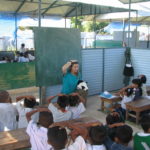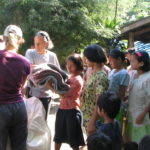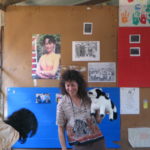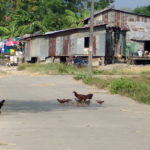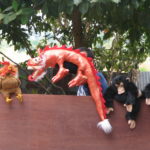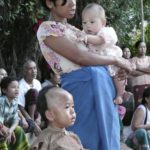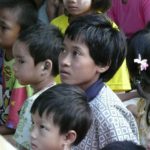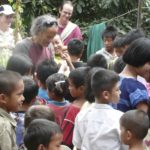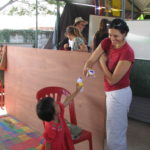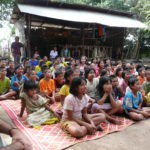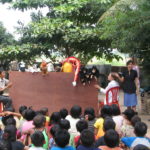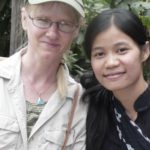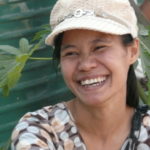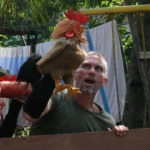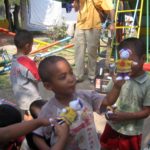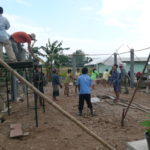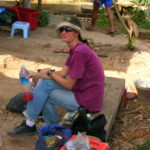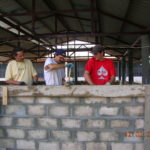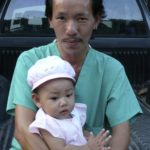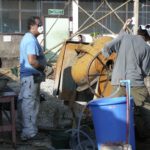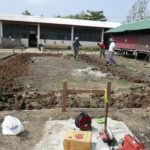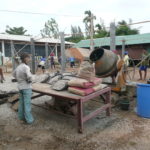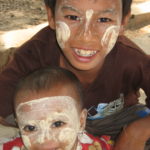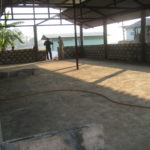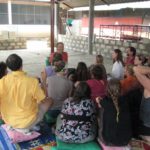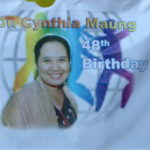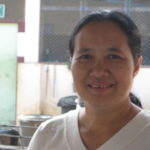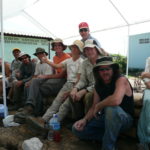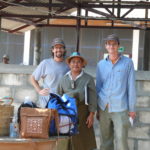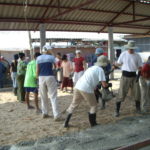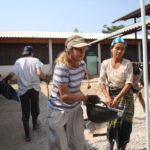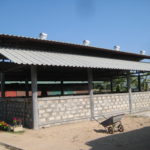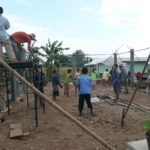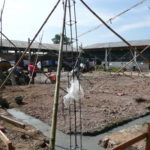THAILAND
With Burmese Refugees
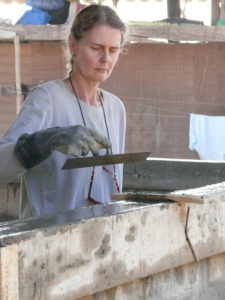 In fall of 2007, nearly 30 volunteers spent varying portions of a 2-month period in Mae Sot, Tak Province, Thailand, near the Burmese border. The good will, donations, and supplies we took with us allowed us to have noticeable impact on so many lives, and in turn to be deeply touched by the individuals we encountered.
In fall of 2007, nearly 30 volunteers spent varying portions of a 2-month period in Mae Sot, Tak Province, Thailand, near the Burmese border. The good will, donations, and supplies we took with us allowed us to have noticeable impact on so many lives, and in turn to be deeply touched by the individuals we encountered.
The majority of our time and effort was spent at the Mae Tao Clinic at our construction site. The sprawling clinic, founded and directed by Dr. Cynthia Maung, is a free health-care facility and temporary safe haven for Burmese patients, refugees, migrant workers, and other individuals who cross the border from Burma into Thailand.
Building for the first time without wood presented new challenges to our seasoned construction crew, but with a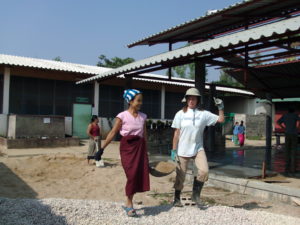 good book, some good sense, and some Burmese helpers, we built an outstanding new building that will be used as an Eye Surgery Clinic. We spent days and days digging, pouring concrete, bending rebar, and laying block, and there was no place that any one of us would rather have been. In fact, most every able-bodied man, woman, and child who encountered the magnetic scene was soon sifting sand, shoveling gravel, or passing buckets of concrete along the human chain.
good book, some good sense, and some Burmese helpers, we built an outstanding new building that will be used as an Eye Surgery Clinic. We spent days and days digging, pouring concrete, bending rebar, and laying block, and there was no place that any one of us would rather have been. In fact, most every able-bodied man, woman, and child who encountered the magnetic scene was soon sifting sand, shoveling gravel, or passing buckets of concrete along the human chain.
We became aware of an organization, Partners, that was preparing a measles vaccination program for children in Burma. We purchased and carried 3,000 syringes from the U.S. for them to get started with the vaccinations. We also gathered medical supply donations in our area and delivered these to the Free Burma Rangers. This organization sends teams of medics into areas under attack within Burma to provide emergency medical care.
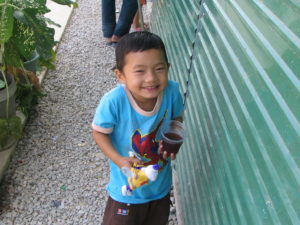 We visited several schools on a weekly basis to do art classes, teach English, and bring hardboiled eggs and milk at lunchtime. We purchased and delivered a variety of sleeping mats, mosquito nets, hundreds of winter blankets, classroom materials for teachers, school supplies, art supplies, sports equipment, and bicycles for three schools that serve hundreds of Burmese children, many of whom were separated from their parents. We arranged for materials and labor for a new roof for both open-air classrooms at one school that serves 110 kindergartners and 1st graders. We had a local shop weld and deliver 3 sets of playground equipment (swings, slides, and see-saws) to two schools and a popular park near the Mae Tao Clinic.
We visited several schools on a weekly basis to do art classes, teach English, and bring hardboiled eggs and milk at lunchtime. We purchased and delivered a variety of sleeping mats, mosquito nets, hundreds of winter blankets, classroom materials for teachers, school supplies, art supplies, sports equipment, and bicycles for three schools that serve hundreds of Burmese children, many of whom were separated from their parents. We arranged for materials and labor for a new roof for both open-air classrooms at one school that serves 110 kindergartners and 1st graders. We had a local shop weld and deliver 3 sets of playground equipment (swings, slides, and see-saws) to two schools and a popular park near the Mae Tao Clinic.
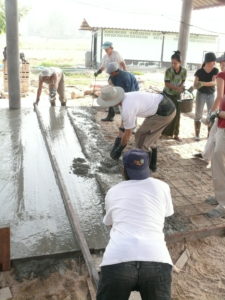 At one orphanage, we spent several days with staple guns and yards and yards of mosquito netting, covering every open space of their three open-air rooms. Malaria is a formidable problem in the area. As the entrance to the orphanage floods in the rainy season and snakes are a problem, we had two truckloads of gravel delivered to raise the walkway and then laid a 75’ long walkway of concrete slabs.
At one orphanage, we spent several days with staple guns and yards and yards of mosquito netting, covering every open space of their three open-air rooms. Malaria is a formidable problem in the area. As the entrance to the orphanage floods in the rainy season and snakes are a problem, we had two truckloads of gravel delivered to raise the walkway and then laid a 75’ long walkway of concrete slabs.
With the magnificent puppets we received from Folkmanis, we put on a number of puppet shows–-at schools, at an orphanage, at the Mae Tao Clinic, and by special request for a large group of HIV patients and their children.
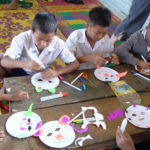 Most all of the items we had purchased for our own use while we stayed in Mae Sot—all the supplies for two kitchens, a dozen cabinets/racks, 25+ folding mattresses, floor mats, blankets, sleeping pillows, sitting pillows, towels, and a dozen fans—were distributed on our final day to a group of very poor families living in a shanty town of wood and tin. Our extra refrigerator, two propane single-burner stoves, and two scooters as well were distributed between the orphanage, schools, and the Clinic.
Most all of the items we had purchased for our own use while we stayed in Mae Sot—all the supplies for two kitchens, a dozen cabinets/racks, 25+ folding mattresses, floor mats, blankets, sleeping pillows, sitting pillows, towels, and a dozen fans—were distributed on our final day to a group of very poor families living in a shanty town of wood and tin. Our extra refrigerator, two propane single-burner stoves, and two scooters as well were distributed between the orphanage, schools, and the Clinic.
Our heartfelt thanks to all who supported our efforts and helped make this extraordinary trip possible.
Building at the Mae Tao Clinic
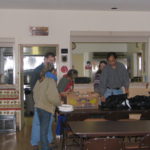 Knowing we had the funds and the crew to take on a sizable project in Mae Sot, we sent out several groups of scouts to investigate possibilities. After one short visit to Dr. Cynthia Maung’s Mae Tao Clinic, it was evident that we had found our spot. The clinic could clearly use all the help we could offer, and we would be exposed daily to the Burmese staff as well as patients, allowing us a first hand glimpse of the impact of the situation in Burma.
Knowing we had the funds and the crew to take on a sizable project in Mae Sot, we sent out several groups of scouts to investigate possibilities. After one short visit to Dr. Cynthia Maung’s Mae Tao Clinic, it was evident that we had found our spot. The clinic could clearly use all the help we could offer, and we would be exposed daily to the Burmese staff as well as patients, allowing us a first hand glimpse of the impact of the situation in Burma.
We were told that a new building would be a tremendous asset, to be used as an eye treatment clinic. We were soon busy acquiring tools, buying materials, laying out the lines, 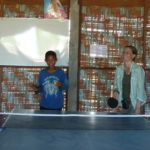 digging the footing, and figuring out how to build in a foreign country with different methods, materials, and so forth. A good way we discovered to research construction methods was to find a building or house under construction, visit it, and observe and discuss what applied to our project. The building site for our 24’ x 48’ structure had dorms on 2 sides, a large kitchen on the third, and a field on the forth. One advantage was that we were essentially right in the middle of a Burmese village. It was a wonderful place for us to spend our time, and enjoyable as well for clinic patients who got to watch us at work each day.
digging the footing, and figuring out how to build in a foreign country with different methods, materials, and so forth. A good way we discovered to research construction methods was to find a building or house under construction, visit it, and observe and discuss what applied to our project. The building site for our 24’ x 48’ structure had dorms on 2 sides, a large kitchen on the third, and a field on the forth. One advantage was that we were essentially right in the middle of a Burmese village. It was a wonderful place for us to spend our time, and enjoyable as well for clinic patients who got to watch us at work each day.
 The clinic already had a strong, skilled crew of workers who took care of labor needs on site. A primary challenge we faced was to establish that we weren’t just giving the clinic money and supplies to build what it needed, but rather our intention was to build it ourselves, with their help when needed. This was clearly a surprise for them, and a bit awkward on both sides in the beginning. I recall a brief good-natured tug of war I had with the Burmese head man over a hammer! The wisdom behind this approach became evident soon later when our mutual participation resulted in the development of some wonderful connections. One thing quickly became clear—sweating together adds strength to any personal connection.
The clinic already had a strong, skilled crew of workers who took care of labor needs on site. A primary challenge we faced was to establish that we weren’t just giving the clinic money and supplies to build what it needed, but rather our intention was to build it ourselves, with their help when needed. This was clearly a surprise for them, and a bit awkward on both sides in the beginning. I recall a brief good-natured tug of war I had with the Burmese head man over a hammer! The wisdom behind this approach became evident soon later when our mutual participation resulted in the development of some wonderful connections. One thing quickly became clear—sweating together adds strength to any personal connection.
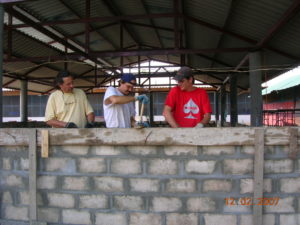 The site location prevented trucks from getting close, so all material had to be carried in—cement, gravel, sand, etc. Once we established ourselves as the primary labor force, whenever we needed help we would inform Thin Thun, the head guy, and immediately a band of Burmese men and women would appear and start helping. As we began mixing concrete for the various stages of construction, it was not uncommon to have a dozen of “us” and a dozen of “them” working side-by-side passing buckets back and forth down the line. Overall, the Burmese were more capable than we—stronger, faster . . . but I think everyone was smiling inside and out when we all worked together.
The site location prevented trucks from getting close, so all material had to be carried in—cement, gravel, sand, etc. Once we established ourselves as the primary labor force, whenever we needed help we would inform Thin Thun, the head guy, and immediately a band of Burmese men and women would appear and start helping. As we began mixing concrete for the various stages of construction, it was not uncommon to have a dozen of “us” and a dozen of “them” working side-by-side passing buckets back and forth down the line. Overall, the Burmese were more capable than we—stronger, faster . . . but I think everyone was smiling inside and out when we all worked together.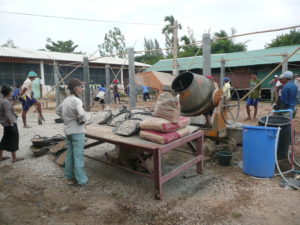
We eventually completed what we set out to accomplish for the Mao Tao Clinic, and left Mae Sot with hearts wrapped in a web of complex feelings—regarding our own extraordinary good fortune and regarding the stark plight of so many of our new Burmese friends and acquaintances.
Oo Nie Kie & the Puppet Shows
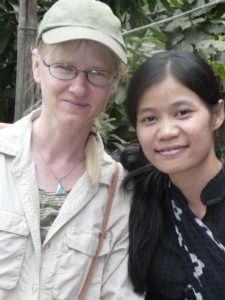 While in Mae Sot as an advance scout, I met members of the Burmese Women’s Union, who provided support and services to Burmese refugees, primarily the women and their families. This group included 24-year-old Oo Nie Kie, who spoke decent English and acted as translator during my visits. The B.W.U. women all wanted to learn English, so for the next weeks I went every morning and did my best to pass on some of the privileged language I was born into.
While in Mae Sot as an advance scout, I met members of the Burmese Women’s Union, who provided support and services to Burmese refugees, primarily the women and their families. This group included 24-year-old Oo Nie Kie, who spoke decent English and acted as translator during my visits. The B.W.U. women all wanted to learn English, so for the next weeks I went every morning and did my best to pass on some of the privileged language I was born into.
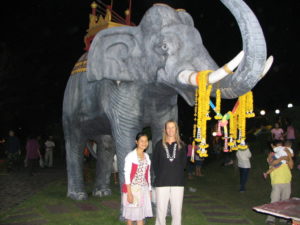 After the arrival of our crew and beginning work on some volunteer projects, it was time to organize the puppet show that we’d practiced at home. The problem, we suddenly realized, was that some of the children we’d be performing for were from Burmese hill tribe villages and spoke Karen, others spoke Burmese, and of course none of them understood English! We needed a translator who was fluent in Burmese, Karen, and English.
After the arrival of our crew and beginning work on some volunteer projects, it was time to organize the puppet show that we’d practiced at home. The problem, we suddenly realized, was that some of the children we’d be performing for were from Burmese hill tribe villages and spoke Karen, others spoke Burmese, and of course none of them understood English! We needed a translator who was fluent in Burmese, Karen, and English.
I thought of Oo Nie Kie, but considered her to be shy and soft spoken. When we approached her with our request and told her that she would need to speak up and be heard at the puppet shows, she laughed. She said that as a little girl in her village, she was nicknamed “Oo Nie Kie Loud-Talker”!
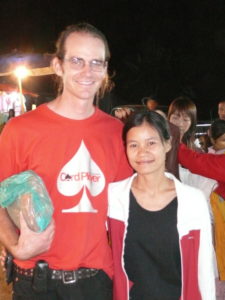 The nickname proved accurate. At our ensuing puppet shows, Oo Nie Kie projected with plenty of volume and was an engaging story-teller. She clearly loved the role she got to play, loved the kids, and they loved her. To be a part of these puppet shows, whether as an organizer, stage hand, coach, narrator, puppeteer, musician, or audience member, was nothing short of enchanting.
The nickname proved accurate. At our ensuing puppet shows, Oo Nie Kie projected with plenty of volume and was an engaging story-teller. She clearly loved the role she got to play, loved the kids, and they loved her. To be a part of these puppet shows, whether as an organizer, stage hand, coach, narrator, puppeteer, musician, or audience member, was nothing short of enchanting.
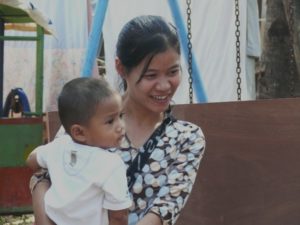 Oo Nie Kie was raised in a Burmese village in Karen State. By the time she was eleven, the family’s animals had died and they could no longer farm because they had to work for the ruling military junta. The next year, their village was destroyed and the family fled to a refugee camp. Eventually, Oo Nie Kie managed to get out of the camp and live in Mae Sot, though she seldom went far from the house she shared with several other Burmese women. Like so many refugees in Thailand, Oo Nie Kie had no documents, and could be stopped, questioned, fined, or arrested at any time. In a truck packed with Westerners, she felt safe enough to join us on one beautiful full-moon evening for a night out to attend the Loi Krathong festival.
Oo Nie Kie was raised in a Burmese village in Karen State. By the time she was eleven, the family’s animals had died and they could no longer farm because they had to work for the ruling military junta. The next year, their village was destroyed and the family fled to a refugee camp. Eventually, Oo Nie Kie managed to get out of the camp and live in Mae Sot, though she seldom went far from the house she shared with several other Burmese women. Like so many refugees in Thailand, Oo Nie Kie had no documents, and could be stopped, questioned, fined, or arrested at any time. In a truck packed with Westerners, she felt safe enough to join us on one beautiful full-moon evening for a night out to attend the Loi Krathong festival.
 Despite the precarious circumstances of her youth in Burma, by age 21 Oo Nie Kie was studying politics in Thailand, had received an internship with the Earth Rights School, and was involved with the Burmese Women’s Union which tries, in her words, “to encourage young Burmese ladies to use their skills . . . and empower them to participate in making life better for Burmese women.”
Despite the precarious circumstances of her youth in Burma, by age 21 Oo Nie Kie was studying politics in Thailand, had received an internship with the Earth Rights School, and was involved with the Burmese Women’s Union which tries, in her words, “to encourage young Burmese ladies to use their skills . . . and empower them to participate in making life better for Burmese women.”
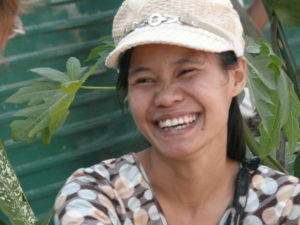 The possibility of applying for relocation to a western country was an attractive option for Oo Nie Kie, nevertheless her feelings of love for and responsibility toward the people who still suffered under the military junta in her homeland made it difficult for her to consider leaving. These feelings ultimately kept her in Thailand where, sometime after our departure, she found a good job at an orphanage on the border. She said that she felt at home there, and that she had finally found her place in the world.
The possibility of applying for relocation to a western country was an attractive option for Oo Nie Kie, nevertheless her feelings of love for and responsibility toward the people who still suffered under the military junta in her homeland made it difficult for her to consider leaving. These feelings ultimately kept her in Thailand where, sometime after our departure, she found a good job at an orphanage on the border. She said that she felt at home there, and that she had finally found her place in the world.
Her untimely death is mourned by all who knew her.
We hope you enjoy these photos of our time together with her.
Visiting Schools
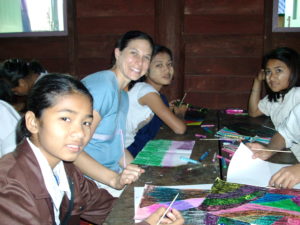 Several times a week, three or four of us would load up our supplies and head out to one of the Burmese migrant schools to teach Art and English. We would plan art projects or activities before arriving and arrange to meet with different grade levels on different days. We usually worked with about 40 students each time. When the children saw us coming, they knew they were in for a fun and interesting time! Upon our arrival, they would run up to us, full of excitement, insistent on helping us carry our supplies. The children were very curious to see
Several times a week, three or four of us would load up our supplies and head out to one of the Burmese migrant schools to teach Art and English. We would plan art projects or activities before arriving and arrange to meet with different grade levels on different days. We usually worked with about 40 students each time. When the children saw us coming, they knew they were in for a fun and interesting time! Upon our arrival, they would run up to us, full of excitement, insistent on helping us carry our supplies. The children were very curious to see 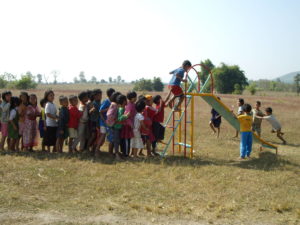 whatever idea we would present for the day and they were incredibly enthusiastic about learning something new.
whatever idea we would present for the day and they were incredibly enthusiastic about learning something new.
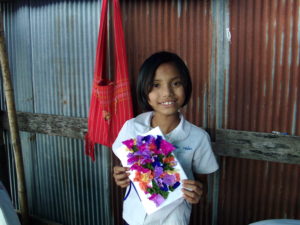 One of their favorite projects was molding clay. First, we would mold an example for the children to see, then pass out a few colorful chunks of clay to each child and watch them go wild creating! It was incredible to watch how creative and focused they would be and how much fun they had. Some days we would bring colored beads for making bracelets and necklaces, or experiment with paints and paper projects. We also discovered some fun ways to teach a little English with puppets, songs, and simple line dances.
One of their favorite projects was molding clay. First, we would mold an example for the children to see, then pass out a few colorful chunks of clay to each child and watch them go wild creating! It was incredible to watch how creative and focused they would be and how much fun they had. Some days we would bring colored beads for making bracelets and necklaces, or experiment with paints and paper projects. We also discovered some fun ways to teach a little English with puppets, songs, and simple line dances.
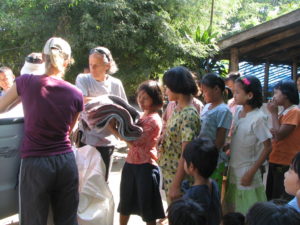 In addition to teaching classes, we did our best to find out the needs of the schools and provide necessary items such as water tanks, school uniforms, wood flooring, metal roofing, basic school supplies, as well as white boards, chairs, and transportation funds. One teacher asked if we could please bring milk and hard-boiled eggs for the children when we came. It was a real treat when we would arrive to teach classes, bringing milk and 100+ eggs to the patiently waiting students.
In addition to teaching classes, we did our best to find out the needs of the schools and provide necessary items such as water tanks, school uniforms, wood flooring, metal roofing, basic school supplies, as well as white boards, chairs, and transportation funds. One teacher asked if we could please bring milk and hard-boiled eggs for the children when we came. It was a real treat when we would arrive to teach classes, bringing milk and 100+ eggs to the patiently waiting students.
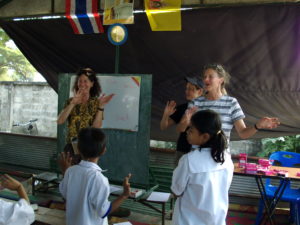 There was so much need, whatever we could contribute was so appreciated. With each thing we did, it was clear that we brought a little more light, joy, and relief into their lives and… certainly, deep emotions and lasting beautiful impressions into our own.
There was so much need, whatever we could contribute was so appreciated. With each thing we did, it was clear that we brought a little more light, joy, and relief into their lives and… certainly, deep emotions and lasting beautiful impressions into our own.

